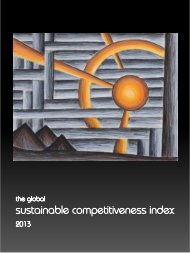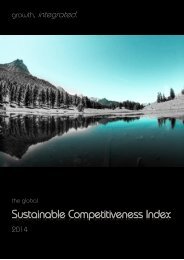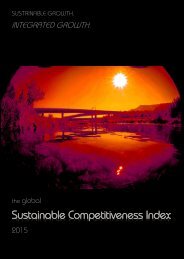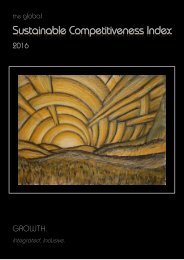Global Competetiveness Report
You also want an ePaper? Increase the reach of your titles
YUMPU automatically turns print PDFs into web optimized ePapers that Google loves.
Scoring<br />
Methodology<br />
Data sources<br />
Data sources were chosen according to their<br />
reputation and reliability (as well as<br />
availability of global data). The largest<br />
percentage of indicators was derived from<br />
the immense wealth of the World Banks<br />
indicator database, followed by data sets<br />
and indicators provided by various UN<br />
agencies.<br />
Calculation<br />
The raw data as provided by the various<br />
databases consist of numerical values. While<br />
values can be ranked against each other,<br />
they cannot be compared or added to other<br />
values (two apples plus three oranges are not<br />
equal to five pineapples). It is therefore<br />
necessary to extract a scalable and<br />
comparable score from the raw data as a first<br />
step. In the second step, the relative<br />
importance of the indicator is assessed<br />
against other indicators to calculate the<br />
sustainability performance.<br />
World<br />
Bank<br />
UNDP<br />
FAO<br />
UNEP<br />
WHO<br />
IMF<br />
Others<br />
Inclusion of trends: analysis over time<br />
Current or recent data on its own limits the<br />
perspective to a momentary picture in time.<br />
Of equal importance are recent trends and<br />
development of the performance. Analysing<br />
trends and developments allows for<br />
understanding of where a country is coming<br />
from, and more importantly, indicates the<br />
direction of future developments. Increasing<br />
agricultural efficiency for example indicates<br />
capability to feed an increasing population,<br />
or the opposite if decreasing. Where sufficient<br />
data series are available, the trend was<br />
calculated for 5 or 10 year periods and<br />
scored to evaluate the current level as well as<br />
the future outlook and sustainability potential<br />
of a country.<br />
2000 2005 2010 2015<br />
While the momentary picture of these two series might<br />
be equal in 2010, the grey series is likely to improve in<br />
the future, whereas the blue line is likely to decrease<br />
The <strong>Global</strong> Sustainable Competitiveness Index<br />
21








